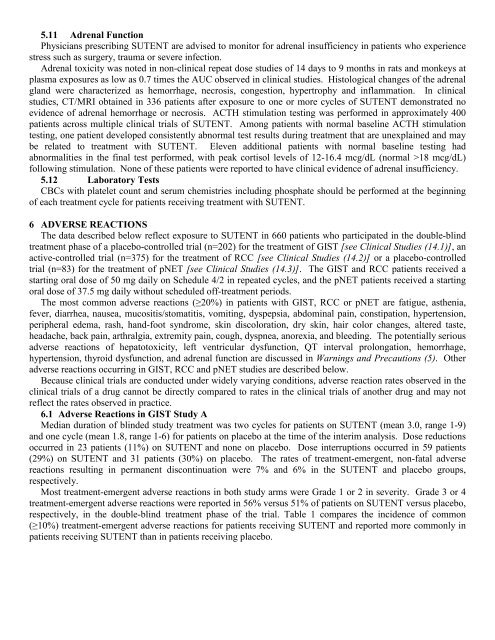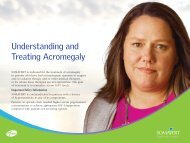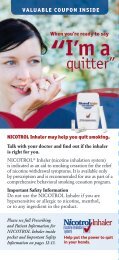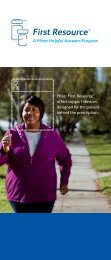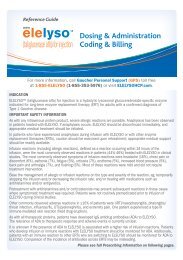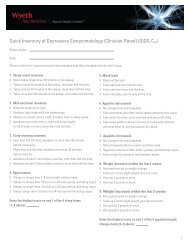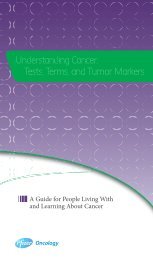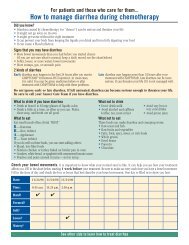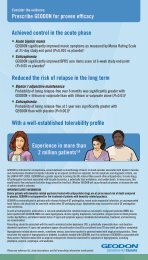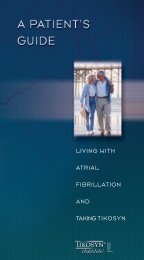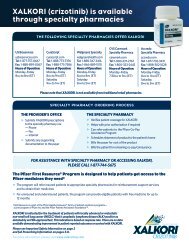Create successful ePaper yourself
Turn your PDF publications into a flip-book with our unique Google optimized e-Paper software.
5.11 Adrenal Function<br />
Physicians prescribing SUTENT are advised to monitor for adrenal insufficiency in patients who experience<br />
stress such as surgery, trauma or severe infection.<br />
Adrenal toxicity was noted in non-clinical repeat dose studies of 14 days to 9 months in rats and monkeys at<br />
plasma exposures as low as 0.7 times the AUC observed in clinical studies. Histological changes of the adrenal<br />
gland were characterized as hemorrhage, necrosis, congestion, hypertrophy and inflammation. In clinical<br />
studies, CT/MRI obtained in 336 patients after exposure to one or more cycles of SUTENT demonstrated no<br />
evidence of adrenal hemorrhage or necrosis. ACTH stimulation testing was performed in approximately 400<br />
patients across multiple clinical trials of SUTENT. Among patients with normal baseline ACTH stimulation<br />
testing, one patient developed consistently abnormal test results during treatment that are unexplained and may<br />
be related to treatment with SUTENT. Eleven additional patients with normal baseline testing had<br />
abnormalities in the final test performed, with peak cortisol levels of 12-16.4 mcg/dL (normal >18 mcg/dL)<br />
following stimulation. None of these patients were reported to have clinical evidence of adrenal insufficiency.<br />
5.12 Laboratory Tests<br />
CBCs with platelet count and serum chemistries including phosphate should be performed at the beginning<br />
of each treatment cycle for patients receiving treatment with SUTENT.<br />
6 ADVERSE REACTIONS<br />
The data described below reflect exposure to SUTENT in 660 patients who participated in the double-blind<br />
treatment phase of a placebo-controlled trial (n=202) for the treatment of GIST [see Clinical Studies (14.1)], an<br />
active-controlled trial (n=375) for the treatment of RCC [see Clinical Studies (14.2)] or a placebo-controlled<br />
trial (n=83) for the treatment of pNET [see Clinical Studies (14.3)]. The GIST and RCC patients received a<br />
starting oral dose of 50 mg daily on Schedule 4/2 in repeated cycles, and the pNET patients received a starting<br />
oral dose of 37.5 mg daily without scheduled off-treatment periods.<br />
The most common adverse reactions (≥20%) in patients with GIST, RCC or pNET are fatigue, asthenia,<br />
fever, diarrhea, nausea, mucositis/stomatitis, vomiting, dyspepsia, abdominal pain, constipation, hypertension,<br />
peripheral edema, rash, hand-foot syndrome, skin discoloration, dry skin, hair color changes, altered taste,<br />
headache, back pain, arthralgia, extremity pain, cough, dyspnea, anorexia, and bleeding. The potentially serious<br />
adverse reactions of hepatotoxicity, left ventricular dysfunction, QT interval prolongation, hemorrhage,<br />
hypertension, thyroid dysfunction, and adrenal function are discussed in Warnings and Precautions (5). Other<br />
adverse reactions occurring in GIST, RCC and pNET studies are described below.<br />
Because clinical trials are conducted under widely varying conditions, adverse reaction rates observed in the<br />
clinical trials of a drug cannot be directly compared to rates in the clinical trials of another drug and may not<br />
reflect the rates observed in practice.<br />
6.1 Adverse Reactions in GIST Study A<br />
Median duration of blinded study treatment was two cycles for patients on SUTENT (mean 3.0, range 1-9)<br />
and one cycle (mean 1.8, range 1-6) for patients on placebo at the time of the interim analysis. Dose reductions<br />
occurred in 23 patients (11%) on SUTENT and none on placebo. Dose interruptions occurred in 59 patients<br />
(29%) on SUTENT and 31 patients (30%) on placebo. The rates of treatment-emergent, non-fatal adverse<br />
reactions resulting in permanent discontinuation were 7% and 6% in the SUTENT and placebo groups,<br />
respectively.<br />
Most treatment-emergent adverse reactions in both study arms were Grade 1 or 2 in severity. Grade 3 or 4<br />
treatment-emergent adverse reactions were reported in 56% versus 51% of patients on SUTENT versus placebo,<br />
respectively, in the double-blind treatment phase of the trial. Table 1 compares the incidence of common<br />
(≥10%) treatment-emergent adverse reactions for patients receiving SUTENT and reported more commonly in<br />
patients receiving SUTENT than in patients receiving placebo.


